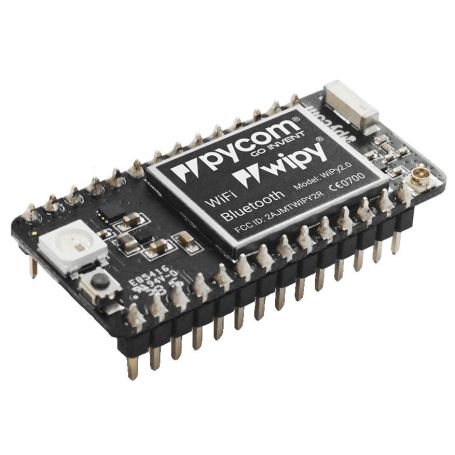[RETIRE] WiPy 3 - IoT with WiFi & Bluetooth
[RETIRE] WiPy 3 - the WiFi microcontroler
- ESP32 under MicroPython,
- WiFi
- Bluetooth (BLE & Classic)
Payments are secured by LyraCollect, a French payment collection company.
It is possible to delivered to your home, to a pick-up point or picked up by appointment at MCHobby
We prepare, pack and ship your orders with great respect and care.
This product is no more available at MCHobby
Description
Here the WiPy 3, the big brother of WiPy 1 & 2.
Wypi is a board for programming an "Internet of the thing" object in python. It is small, affordable, low power. The board is programmed with MicroPython (support for the Python 3 syntax), a version of python taillored and optimized to increase performances and reduce the memory footprint. MicroPython is able to run on microcontroler that reached a minimum of power. No need of a compiler onyour computer, the microcontroler is able to digest and interprete the python script. Since it is Python then it works like the Python on your computer. With python the learning curve is very good!
Before starting your hacking session, you will need a power supply (between 3.3 and 5.5v) and a WiFi connection. You can use the WiPy extension board to help you with the power supply of the WiPy.
WiPy is autonomous, it doesn't need any Cloud service. No need to compile and store library to run your software. The board parse and runs natively your python scripts.
With the WiPy, you will be able to create and connect your things everywhere and in a fast way.
Introducing the WiPy 3, the tiny Micro Python enabled WiFi & Bluetooth IoT development platform. With a 1KM WiFi range, state of the art Espressif ESP32 chipset and dual processor, the WiPy is all about taking the Internet of Things to the next level.
Under the roof of the WiPy 3:
- Espressif ESP32 chipset
- Dual processor + WiFi radio System on Chip.
- Network processor handles the WiFi connectivity and the IPv6 stack.
- Main processor is entirely free to run the user application.
- An extra ULP-coprocessor that can monitor GPIOs, the ADC channels and control most of the internal peripherals during
- deep-sleep mode while only consuming 25µA
- RTC Running at 32KHz
- Power: 3.3V to 5.5V
3V3 output capable of sourcing up to 500mA
Key features:
- Use the Pymakr IDE
Super easy code editor to write your Python scripts. - Quick Verification
For easy and fast debugging use the interactive shell that is accessible through telnet or one of the serial ports. - Easy Upload
Upload your scripts, and any other files you want to the WiPy via the FTP server - Locally or remotely
Reset the WiPy (you can do it locally, or remotely via Telnet)
The maker would appreciate the interfacing and library support for the WiPy 3
Interfacing:
- 2 x UART, 2 x SPI, I2C, I2S, micro SD card
- Analog channels: 8x12 bit ADCs
- Timers: 4x16 bit with PWM and input capture
- DMA on all peripherals
- GPIO: Up to 24
Memory:
- RAM: 512KB
External flash 4MB - Hardware floating point acceleration.
- Python multi-threading.
Security & Certifications:
- SSL/TLS support
- WPA Enterprise security
- FCC - 2AJMTWIPY2R
- CE 0700
- Hash / encryption: SHA, MD5, DES, AES
Wifi:
- 802.11b/g/n 16mbps
Bluetooth:
- Low energy and classic
With dozens of ready to use templates and libraries soon to be available on the Pycom Exchange, developing a new
IoT solution is now easier and faster. Additional support for Blynk:
- SMTP,
- MQTT,
- URLLIB,
- ONEWIRE,
- Accelerometer,
Event loop MicroPython together with the universal hardware API allow us to build a large set of powerful, robust, and portable libraries across hardware platforms
Technical details
- Powerful CPU, BLE and state of the art WiFi radio
- 1KM WiFi Range
- MicroPython enabled, the Linux of IoT for fast deployment
- Fits in a standard breadboard (with headers)
- Ultra-low power usage: a fraction compared to other connected micro controllers
- Hardware floating point acceleration
- Python multi-threading
- Poids: 50.05 gr
- Dimensions: 42mm x 20mm x 3.5mm (excluding headers)
Tutorial
- Documentation about PyCom products (english)
- Specification and getting started guide (english)










